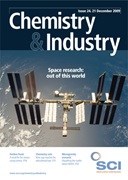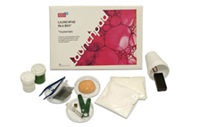Children’s traditional chemistry sets may be losing popularity, but there are plenty of other chemistry-related toys for budding chemists. Lou Reade reports
From its origins as 18th century ‘chemical chests’, through its heyday in the 1950s, the Christmas present that inspired lab technicians and Nobel prize-winners alike may be heading the way of the spinning top and the rocking horse. But all is not lost. While the traditional chemistry set is no longer a bestseller, there are plenty of other toys and ‘science kits’ to inspire the chemists of tomorrow. For a modest outlay, your child – with your expert assistance – can now make synthetic snow, blow enormous bubbles, make volcanoes, create perfume and soap, study smart materials and turn pieces of fruit into batteries. And learn some chemistry in the process.
Whiz-bang, fizz…
Melissa Symonds, of market research company NPD, says that UK sales of ‘scientific toys’ will reach around £14m in 2009. ‘These sales are moving in line with the rest of the market,’ she says. She points to one particular star this year: ‘Explosive Experiments’, which does exactly what it says on the box. It has seen a 29% year-on-year increase in sales, making it the third most popular science toy – after ‘Ant World’ and ‘Hot Wires’.
Explosive science
Hal Sosabowski, a lecturer at Brighton University, knows all about explosions. As ‘Dr Hal’ he organises a chemistry roadshow, ‘The Bigger Bang’, which focuses on the explosive nature of chemistry. His experiments include burning white phosphorus with liquid oxygen. ‘These kinds of experiment will never be done in school,’ he says. ‘Health and safety regulations mean that many teachers can’t or won’t do some experiments.’
While his own son has a chemistry set, Sosabowski believes that ‘backyard science’ is a more powerful way of learning. ‘I prefer kids to make their own experiments,’ he says. ‘I want to nurture their curiosity.’
He’s a fan of shop-bought science kits if they can do this, but is adamant that children must learn something at the same time. ‘I worry that some of these kits may be trivialising science. I’d like to see a return to the good old-fashioned chemistry set – and not to be frightened of learning.’
Sosabowski does, however, have positive things to say about the ‘Horrible Science’ kits, which ‘appeal to the sense of the macabre’; examples include Eerie Eyeball and Bulging Brains.
As part of his mission to promote ‘camouflaged learning’, Sosabowski has devised a set of sciencethemed ‘Top Trumps’ cards (see Box 1). ‘When I die, I want to leave a few more people interested in science,’ he says. ‘That’s my legacy.’
Safety first
For Sosabowski – and others – the modern obsession with health and safety is a major factor in the demise of chemistry sets. This has wider ramifications: for many teachers, regulations are threatening to squash any sense of curiosity that a child may have. Chris George, head of science at the Royal Latin School in Buckinghamshire, says: ‘I tell my team that we need to do things safely – but we don’t want to get rid of “wow” experiments.’
He says it is increasingly difficult for schools to perform these experiments, citing an example of the local council banning chemicals such as potassium chlorate. For him, this attitude has had a knock-on effect on toys such as science kits. ‘These can be fun, but many are too prescribed,’ he says. ‘You get a single outcome, and there’s no sense of experimentation. I think there are lots of interesting kits that make children think. That’s what we need.’
Like Sosabowski, George is a fan of ‘do-ityourself’ science. What would he recommend as a good home experiment? ‘One that we show to six-year-olds is how to make your own lava lamp,’ he says.
A sample bottle – saved from your last visit to the doctor – is half-filled with coloured water. Oil is then poured on top, leaving a reasonable headspace. Then, part of an Alka Seltzer tablet is dropped through the oil into the aqueous layer. Droplets of coloured water will soon be lifted through the oil layer by carbon dioxide bubbles. The bubbles then disperse, and the water falls back.
‘Make sure you leave a headspace, or you’ll get an explosion – but that’s fun as well,’ he says.
Festive best sellers
But what’s hot in the run-up to Christmas this year? Online retailer BrightMinds – which sells educational toys such as science kits and arts and crafts – was set up by former science teacher Alison Quill. ‘Our best sellers are always science toys,’ she says. ‘I think it’s what most eight-10 year olds are fascinated by. It’s a shame they switch off by the time they’re 15.’
Her sales in for the first three weeks of November show that kits to make perfume or grow crystals are outselling £30 ‘senior’ chemistry sets by two-to-one; kits to make giant bubbles are five times more popular.
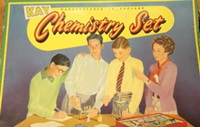
A popular choice is the ‘Smart Materials’ kit, which according to the packaging is ‘not a toy’. It includes samples of shape memory alloy wire, colour-changing film and smart putty. In one experiment, the wire is bent around a rod and ‘trained’ to remember that particular shape. Most science kits tend to be ‘older stuff in new packaging’: the Smart Materials kit includes new samples – such as the shape memory alloy wire – that are now cheap enough to include within an affordable toy.
This will be seen more often in future, says Quill. Logiblocs hit the mass market when the components became cheap enough. The same may be true for chemistry toys in future. One top-end toy is a remote-controlled car that is powered by a fuel cell. Time will tell if it becomes a mass-market favourite.
‘When technology becomes affordable, you will see it appear in toys,’ says Quill.
Bearing in mind the general antithesis to chemistry sets, should you buy one for your child this Christmas? ‘Absolutely,’ says Royal Latin School’s Chris George. ‘But it’s better if parents have some knowledge, so it can still be used after the chemicals have run out.’
Coming up trumps
My nine-year-old son was the ideal person to challenge to a game of ‘Dr Hal’s Chemistry Top Trumps’ – as he is a keen purveyor of ‘Match Attax’ and the impenetrable Yu-Gi-Oh cards. Dr Hal’s cards classify 32 chemical elements – the first 20 of the periodic table, plus a few select heavyweights, like iron and gold, and oddities, like americium – using five attributes: atomic mass, melting point, year of discovery, ‘danger factor’ and ‘usefulness’.
A short, lively paragraph – which was read keenly on each turn – explains some key facts. His favourite? ‘The Latin name for lead is Plum-BUM!’
For kids who like Top Trumps and similar games, this is a highly entertaining way of introducing them to the basics of chemistry.
I enjoyed showing off, by trying to guess my son’s card based on its atomic mass. Within weeks, I’m sure he’ll be guessing my card based on its year of discovery. I only hope he overcomes his low opinion of helium: because of its low atomic mass and melting point, lack of danger, and relatively recent discovery, it’s not the most powerful card in the deck. My son now thinks it is ‘a rubbish element’.
Elementeo: a game of chemical properties and personalities
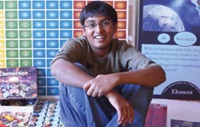
What are the basic rules of Elementeo?
Elements have their own personalities, and fight with each other using their properties and oxidation states: Oxygen Life Giver rusts metals, for example, while Copper Cyclops shocks element cards around him. Chemistry principles are incorporated into gameplay. For example, gases like Hydrogen Stargazer move diagonally across the board – due to their light weight – while metals like Sodium Dragon can only move forwards. The game contains 121 cards – elements, compounds, and alchemy cards – along with a battlefield, rulebook, electron chips and die.
Why did you devise it?
I realised that the words ‘education’ and ‘fun’ had two completely different meanings to my peers. Chemistry was seen as long formulas and stinky odours, and ‘fun’ as something not-science. An idea popped into my head of creating a game where learning would happen as a side effect of fun.
Who will play it – and what will they get from it?
Students will learn properties of elements and compounds, and have fun with chemistry without even knowing it. The game is meant for 3rd - 8th graders, but college graduates can enjoy it at an entirely different level – we recently had a Stanford v Berkeley battle.
Are you planning anything similar?
Elementeo is the first game for my company, Alchemist Empire. As the company name suggests, the goal is to make an empire: we hope to expand Elementeo to multiple subjects as well as multiple game mediums in the future.
Power from potatoes
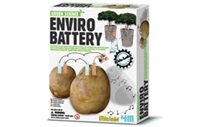
This year, simply hand your child a potato and say: ‘This can be used as a battery.’ Once the tantrum has subsided, whip out a last-minute present, ‘Enviro Battery’ – a kit from Kidz Labs that illustrates the principles of electrochemistry without a single shop-bought battery. Instead, it uses fruit, vegetables and vinegar to power a small light bulb, sound chip or clock. My seven-year old son, whose love for batteryoperated games knows no bounds, was so captivated that he ignored the TV for almost half an hour.
Quite against the rules, I showed him that a standard battery would light the light or make the sound chip vibrate. Then we followed the colourful instructions by creating a circuit from two potatoes and two (supplied) electrodes. One very clever experiment was to make a sandwich of aluminium foil, vinegar-soaked cotton pads and 2p pieces, held together in a clothes peg and connected up with the sound chip – voila, a ‘singing coin’.
If I’m feeling adventurous over the festive season, I may try electrolysing some vinegar water to make hydrogen and oxygen. It may be the only bit of fresh air I get until the New Year!

